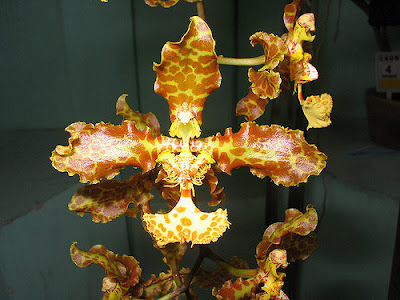The Stacy's Oncidium is native to Bolivia and Peru. In Peru, these orchids were encountered near Manú in the Department of Madre de Dios. They grew there high in the treetops of a tropical forest at an altitude of about 450 m. This plant is a medium sized, hot growing epiphyte with ovoid-cylindric pseudobulbs (2.5 cm long or more and 0.8 cm in diameter) that are enveloped by several pairs of small scarious imbricate bracts with a single, apical, pendant, channeled, apex pointed, lightly arcuate, stiffly coriaceous, terete leaf. The leaves are 80 cm long or more and 0.8 cm in diameter.
Oncidium stacyi orchid, also called as Stacy's Oncidium, Cohniella stacyi, Lophiaris wittii, Oncidium wittii, Stilifolium stacyi, Trichocentrum stacyi, is a species of the genus Oncidium. This species was first described by Garay in 1973.
IDENTIFY ONCIDIUM STACYI ORCHID
The Stacy's Oncidium is native to Bolivia and Peru. In Peru, these orchids were encountered near Manú in the Department of Madre de Dios. They grew there high in the treetops of a tropical forest at an altitude of about 450 m.
This plant is a medium sized, hot growing epiphyte with ovoid-cylindric pseudobulbs (2.5 cm long or more and 0.8 cm in diameter) that are enveloped by several pairs of small scarious imbricate bracts with a single, apical, pendant, channeled, apex pointed, lightly arcuate, stiffly coriaceous, terete leaf. The leaves are 80 cm long or more and 0.8 cm in diameter.
It blooms in the spring on a basal, lightly fractiflex, erect to arcuate, 8" (20 cm) long, racemose inflorescence, with 5 to 6 small lanceolate bracts and a narrowly elliptic, concave, long tapered to a laterally compressed, triangular long pointed apicaule floral bract, arising from a mature pseudobulb with many (14 to 20) showy flowers. Large, stately, widely spread flowers are up to 8 cm in diameter. The petals of both whorls are golden-yellow, but quite densely marked with dark, cinnamon-brown dots and irregularly shaped spots. The lip is intensely yellow and has reddish cinnamon-brown spots and spots, and the protuberance at the base of the lip is light yellow with reddish edges. The spine is intensely yellow with vertical reddish lines, and the yellow cap of the anther chamber has tiny red dots.
GROW AND CARE ONCIDIUM STACYI ORCHID
Cultural information should only be used as a guide, and should be to be adapted to suit you. Your physical location; where you grow your plants, how much time you have to devote to their care, and many other factors, will need to be taken into account. Only then can you decide on the cultural methods that best suit you and your plants.
Light:
Oncidium stacyi orchid need light source of 20000-30000 lux. The light should be filtered or dispersed, and the plants should not be exposed to the direct sunlight of the midday sun. Strong air movement should be ensured all the time.
Temperature:
The average temperature of the summer day is 29 ° C, the night 19-21 ° C, and the daily difference is 8-19 ° C. At the end of winter and at the beginning of spring, when the dry season ends, the average day temperature is 31-32 ° C. The average temperature of the winter day is 29-32 ° C, the night 14-16 ° C, and the daily difference is 13-17 ° C.
Humidity:
There is no average humidity data for the given location, but data from nearby stations indicate a probable value of 75-80% for most of the year and a drop to 70% for about a month at the end of winter.
Substrate and growing medium:
The dangling shape and the fact that these plants do not like "wet feet" makes it the easiest to grow them mounted on corkscrews. When the plants are not mounted, they are most often grown in hanging pots or baskets filled with loose, fast-drying ground, such as medium-sized bark pieces or chopped tree fern fibers. The addition of perlite helps to keep the substrate cool, but also stops some of the moisture. You can also add charcoal, which not only improves the airiness of the substrate, but also prevents it from getting sour.
Watering:
From spring to autumn, precipitation is moderate to heavy. At the end of autumn and at the beginning of winter, their number decreases slightly, and at the end of winter, there is a shorter dry season. Cultivated plants should be abundantly watered during active growth, but excellent drainage should be ensured because the substrate around the roots can never be soggy or stale. When new growths reach maturity in autumn, the amount of water should be reduced.
It is necessary to ensure high humidity and watering in summer at least once a day. During hot and dry weather, it may be necessary to water several times a day.
Fertilizer:
Weekly use of 1/4-1/2 of the recommended dose of orchid fertilizer is recommended. Fertilization should be reduced or eliminated until new growth appears in the spring and more watering should be undertaken.
Rest period and repotting:
In a natural habitat, rainfall is lower than the end of autumn until the beginning of spring, but there is only one month really dry at the end of winter.
Plants must be repotted when the substrate begins to decompose, or when they grow out of pots. However, it is best to overdo it every year before the substrate begins to decompose. Repotting should be done when new roots begin to grow, because then the plant will stabilize as soon as possible.















COMMENTS